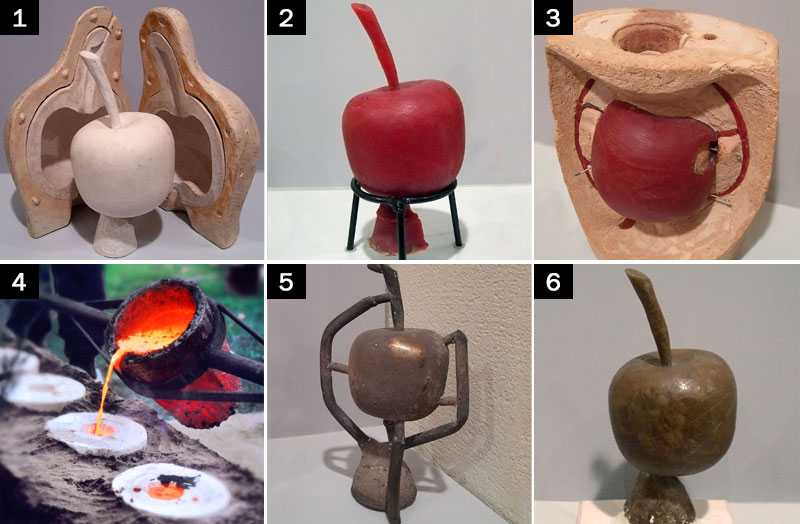Lost Wax Casting
Contents |
[edit] What is lost wax casting?
Lost wax casting is a metal casting technique that utilises wax moulds to create intricate, detailed metal structures. Also known as cire perdue or precision casting, molten metal is poured into casts created from wax sculptures. Lost wax casting allows the creation of thin walls and lightweight components.
[edit] Lost wax casting process
Casting metal components using the lost wax casting process allows you to create precise components with difficult structures:
- A wax model is created. This model can only be used once. Large scale productions 3D print prototypes for quick results.
- Once the wax model has been created the cast must be created. This can be done in a number of ways. A popular technique is to surround the wax mould in plaster until it solidifies.
- The wax-plaster mixture is then heated up so the wax melts and can be removed from the cast.
- Molten metal is then poured into the mould until it has solidified.
- The plaster is then removed leaving the metal structure. From there the metal component is then machined and trimmed to the desired shape.
[edit] History of lost wax casting
This form of metal casting is first recorded 6,000 years ago, used by the Indus Valley Civilization to create a copper, wheel-shaped amulet. Early practises used wax from beehives to create the desired structure. In ancient Athens, they used to use clay moulds to create casting for statues and jewellery.
[edit] Positives and negatives of lost wax casting
Positives:
- It can be used to create complex shapes, with very delicate features.
- It can save material waste and can be used for mass production.
- It can cast any material with very few restrictions, such as aluminium, magnesium, copper, and steel.
- It can be used for rapid, low-cost production.
Negatives:
- It cannot produce large components.
- It requires a large amount of preparation and specialist equipment.
- It is a more complicated method compared to other casting processes.
[edit] Related articles on Designing Buildings
- Accessories cast into in situ concrete.
- Aluminium.
- Bronze.
- Cast iron.
- Cast metal components.
- Cast plate.
- Cast-in-place concrete.
- Cast-iron.
- Copper.
- Difference between cast iron and wrought iron.
- Failure of cast iron beams.
- Ferrous.
- Iron.
- Major cast metal components.
- Metal fabrication
- Metalwork.
- Pre-cast concrete.
- Soldering.
- Steel.
- Tin.
- Types of metal.
- Types of steel.
Featured articles and news
RTPI leader to become new CIOB Chief Executive Officer
Dr Victoria Hills MRTPI, FICE to take over after Caroline Gumble’s departure.
Social and affordable housing, a long term plan for delivery
The “Delivering a Decade of Renewal for Social and Affordable Housing” strategy sets out future path.
A change to adoptive architecture
Effects of global weather warming on architectural detailing, material choice and human interaction.
The proposed publicly owned and backed subsidiary of Homes England, to facilitate new homes.
How big is the problem and what can we do to mitigate the effects?
Overheating guidance and tools for building designers
A number of cool guides to help with the heat.
The UK's Modern Industrial Strategy: A 10 year plan
Previous consultation criticism, current key elements and general support with some persisting reservations.
Building Safety Regulator reforms
New roles, new staff and a new fast track service pave the way for a single construction regulator.
Architectural Technologist CPDs and Communications
CIAT CPD… and how you can do it!
Cooling centres and cool spaces
Managing extreme heat in cities by directing the public to places for heat stress relief and water sources.
Winter gardens: A brief history and warm variations
Extending the season with glass in different forms and terms.
Restoring Great Yarmouth's Winter Gardens
Transforming one of the least sustainable constructions imaginable.
Construction Skills Mission Board launch sector drive
Newly formed government and industry collaboration set strategy for recruiting an additional 100,000 construction workers a year.
New Architects Code comes into effect in September 2025
ARB Architects Code of Conduct and Practice available with ongoing consultation regarding guidance.
Welsh Skills Body (Medr) launches ambitious plan
The new skills body brings together funding and regulation of tertiary education and research for the devolved nation.
Paul Gandy FCIOB announced as next CIOB President
Former Tilbury Douglas CEO takes helm.
UK Infrastructure: A 10 Year Strategy. In brief with reactions
With the National Infrastructure and Service Transformation Authority (NISTA).























